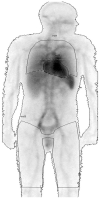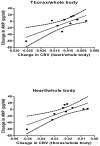Atrial Natriuretic Peptide and Acute Changes in Central Blood Volume by Hyperthermia in Healthy Humans
- PMID: 28018493
- PMCID: PMC5178974
- DOI: 10.2174/1876528901205010001
Atrial Natriuretic Peptide and Acute Changes in Central Blood Volume by Hyperthermia in Healthy Humans
Abstract
Background: Hyperthermia induces vasodilatation that reduces central blood volume (CBV), central venous pressure (CVP) and mean arterial pressure (MAP). Inhibition of atrial natriuretic peptide (ANP) could be a relevant homeostatic defense mechanism during hyperthermia with a decrease in CBV. The present study evaluated how changes in plasma ANP reflect the changes in CBV during hyperthermia.
Methods: Ten healthy subjects provided with a water perfused body suit increased body core temperature 1 °C. In situ labeled autologous red blood cells were used to measure the CBV with a gamma camera. Regions of interest were traced manually on the images of the whole body blood pool scans. Two measures of CBV were used: Heart/whole body ratio and thorax/whole body ratio. CVP and MAP were recorded. Arterial (ANPart) and venous plasma ANP were determined by radioimmunoassay.
Results: The ratio thorax/whole body and heart/whole body decreased 7 % and 11 %, respectively (p<0.001). MAP and CVP decreased during hyperthermia by 6.8 and 5.0 mmHg, respectively (p<0.05; p<0.001). Changes in both thorax/whole body (R=0.80; p<0.01) and heart/whole body ratios (R=0.78; p<0.01) were correlated with changes in ANPart. However, there was no correlation between venous ANP and changes in CBV, nor between ANPart and MAP or CVP.
Conclusion: Arterial but not venous plasma concentration of ANP, is correlated to changes in CBV, but not to pressures. We suggest that plasma ANPart may be used as a surrogate marker of acute CBV changes.
Keywords: ANP; blood pool imaging; central blood volume; heating; natriuretic peptides; nuclear medicine.
Figures


Similar articles
-
Cardiac output during exercise is related to plasma atrial natriuretic peptide but not to central venous pressure in humans.Exp Physiol. 2019 Mar;104(3):379-384. doi: 10.1113/EP087522. Exp Physiol. 2019. PMID: 30673144
-
Plasma atrial natriuretic peptide and haemodynamics in conscious normotensive and spontaneously hypertensive rats after acute blood volume expansion.J Hypertens Suppl. 1985 Dec;3(3):S311-3. J Hypertens Suppl. 1985. PMID: 2856725
-
Haemodynamics and plasma ANP (atrial natriuretic peptide) after acute blood volume expansion in normotensive and spontaneously hypertensive rats.Acta Physiol Scand. 1988 Aug;133(4):513-8. doi: 10.1111/j.1748-1716.1988.tb08435.x. Acta Physiol Scand. 1988. PMID: 2976235
-
Circulating atrial natriuretic peptide (ANP) and central blood volume (CBV) in cirrhosis.Liver. 1986 Dec;6(6):361-8. doi: 10.1111/j.1600-0676.1986.tb00305.x. Liver. 1986. PMID: 2952859
-
Role of atrial natriuretic peptide in long-term volume homeostasis.Clin Exp Pharmacol Physiol. 1995 Jan;22(1):55-61. doi: 10.1111/j.1440-1681.1995.tb01919.x. Clin Exp Pharmacol Physiol. 1995. PMID: 7768035 Review.
Cited by
-
Mid-regional plasma pro-atrial natriuretic peptide and stroke volume responsiveness for detecting deviations in central blood volume following major abdominal surgery.Acta Anaesthesiol Scand. 2022 Oct;66(9):1061-1069. doi: 10.1111/aas.14126. Epub 2022 Sep 7. Acta Anaesthesiol Scand. 2022. PMID: 36069352 Free PMC article.
-
Effect of hypotensive hypovolemia and thoracic epidural anesthesia on plasma pro-atrial natriuretic peptide to indicate deviations in central blood volume in pigs: a blinded, randomized controlled trial.Local Reg Anesth. 2019 Jun 25;12:47-55. doi: 10.2147/LRA.S204594. eCollection 2019. Local Reg Anesth. 2019. PMID: 31417302 Free PMC article.
-
Meta-analysis of heat-induced changes in cardiac function from over 400 laboratory-based heat exposure studies.Nat Commun. 2025 Mar 14;16(1):2543. doi: 10.1038/s41467-025-57868-6. Nat Commun. 2025. PMID: 40087302 Free PMC article.
-
Intradermal administration of atrial natriuretic peptide has no effect on sweating and cutaneous vasodilator responses in young male adults.Temperature (Austin). 2017 Oct 9;4(4):406-413. doi: 10.1080/23328940.2017.1356433. eCollection 2017. Temperature (Austin). 2017. PMID: 29435479 Free PMC article.
-
Effect of adrenaline on serum mid-regional pro-atrial natriuretic peptide and central blood volume.Exp Physiol. 2022 Sep;107(9):1037-1045. doi: 10.1113/EP090516. Epub 2022 Aug 21. Exp Physiol. 2022. PMID: 35912634 Free PMC article.
References
-
- Rowell LB, Brengelmann GL, Murray JA. Cardiovascular responses to sustained high skin temperature in resting man. J Appl Physiol. 1969;27(5):673–80. - PubMed
-
- Crandall CG, Levine BD, Etzel RA. Effect of increasing central venous pressure during passive heating on skin blood flow. J Appl Physiol. 1999;86(2):605–10. - PubMed
-
- Low DA, Purvis AJ, Reilly T, Cable NT. The prolactin responses to active and passive heating in man. Exp Physiol. 2005;90(6):909–17. - PubMed
-
- Minson CT, Wladkowski SL, Cardell AF, Pawelczyk JA, Kenney WL. Age alters the cardiovascular response to direct passive heating. J Appl Physiol. 1998;84(4):1323–32. - PubMed
-
- Stein BC, Levin RI. Natriuretic peptides: physiology, therapeutic potential, and risk stratification in ischemic heart disease. Am Heart J. 1998;135(5 Pt 1):914–23. - PubMed
Grants and funding
LinkOut - more resources
Full Text Sources
